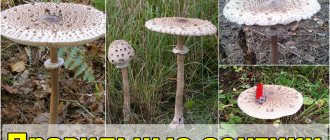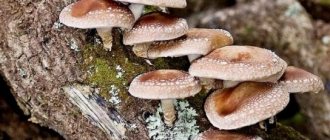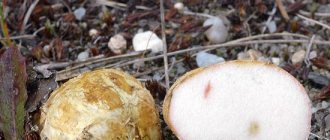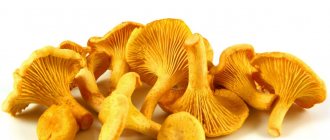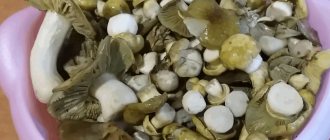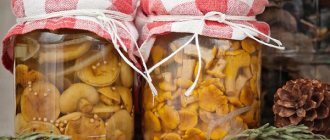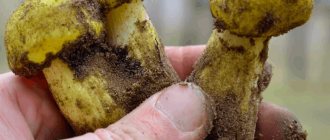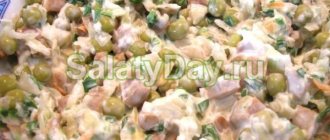Lepiota rougha has received many synonymous names due to its memorable appearance. It is called “rough umbrella”, acute scale lepiota, sepal and so on. The mushroom is a prominent representative of the champignon or agaricaceae family. Belongs to the order agaricaceae, lamellar.
Due to its specific smell, this mushroom is classified as inedible. Due to the fact that it is similar to its poisonous relatives, this mushroom is not worth collecting in a basket, even if the smell and aroma do not bother you.
From Latin - Lepiota acute squamosa .
Therefore, if you are not well versed in the varieties of mushrooms, you should not cut the lepiota acute scale into your basket, because you can easily make a mistake and try a poisonous mushroom.
Description of Lepiota rosea
The cap of Lepiota rosea has a diameter of 2-5 centimeters; its shape is convex-spread or flat-spread.
The edges of the cap are slightly curved inward. Its color is ocher-pink. The surface of the cap is completely covered with tightly pressed scales. The color of the plates is wine brown. Lepiota rosea is a lamellar mushroom. The plates are free, very frequent, and wide. The color of the plates is cream with a slight greenish tint. The pulp is dense. The color of the flesh of the cap and the upper part of the leg is cream-colored, and the lower part of the leg is a meat color.
The leg of the serrated umbrella is cylindrical, of average length - 2.5-4 centimeters and with a diameter of up to 0.35 centimeters. In the middle of the leg there is a characteristic fibrous ring. Above the ring, the leg is light gray, and its lower part is dark gray.
Externally, lepiots are very similar to umbrella mushrooms, but are smaller in size. And the rest of the generic characteristics (a cap that looks like an open umbrella, fibrous scales and a stationary ring on the stem) are completely the same for these mushrooms.
Places of distribution of serrated umbrellas
Serrated umbrellas are common in Western Europe: France, Belgium, Italy, Denmark, Hungary, Germany, Great Britain, as well as in Russia and Kazakhstan. These mushrooms grow among grass, in meadows. Active growth of Lepiota rosea is observed from mid-June to the end of August. Lepiots are saprophytes, meaning they feed on decaying debris in the soil.
Toxicity of Lepiota rosea
This mushroom should never be tasted - lepiota rosea is a deadly poisonous species, it contains cyanides that cause serious poisoning.
Similar species
There are approximately 50 species in the genus, with 7 species classified as poisonous and 3 as deadly poisonous, and there are also little-known edible species in the genus, for example, the parasol. But lepiots are very difficult to distinguish, and since there are deadly poisonous species in the genus, it is recommended not to collect these mushrooms at all.
Related species
The following species grow on the territory of Russia and Europe:
- Lepiota chestnut has a cap with a diameter of 2-4 centimeters. At first its shape is almost ovoid, but over time it becomes flat. The color of the cap is yellow-brown or red-brown with chestnut-colored felt scales. The length of the leg is 2-5 centimeters. These mushrooms bear fruit from July to September. They grow in forests, gardens, and along ditches. Rarely seen. They live in groups.
- Lepiota poisonous has a rounded cap with an unpronounced tubercle. The color of the cap is gray-red. The surface of the cap is matte with a large number of pressed scales. The leg is low, cylindrical, pink in color. It has a very fragile whitish ring on it. These mushrooms are found from June to August. They grow in Western Europe, Ukraine. You can find them among the grass in meadows and parks. This is a rare species. It bears fruit exclusively in autumn.
- Lepiota rougha, Lepiota combata, Lepiota swellspore and Lepiota thyroid are highly suspected of being poisonous;
- Leptiota redplate is an edible mushroom;
- Lepiota corypus is classified as a conditionally edible mushroom that is suitable for frying and boiling.
Notes
- ↑
- ↑
- Vyacheslav Stepanov.
. Mushrooms of the Kaluga region. Retrieved June 21, 2011. - Quélet, Lucien.
Enchiridion Fungorum in Europa media et praesertim in Gallia Vigentium. - Lutetiae: O. Doin, 1886. - 352 p. - ↑ Kuo, M.
. Retrieved July 12, 2011. - (unavailable link). Roger's Mushrooms. Retrieved July 12, 2011.
- Keller C, Maillard M, Keller J, Hostettmann K.
Screening of European fungi for antibacterial, antifungal, larvicidal, molluscidal, antioxidant and free-radical scavenging activities and subsequent isolation of bioactive compounds // Pharmaceutical Biology. - Taylor and Francis Ltd, 2002. - T. 40, No. 7. - P. 518-525.
Looking for silverfish
You should start your search from the dampest places in your home: bath, toilet, kitchen. Inspect various cracks especially carefully - thanks to their narrow body, these insects can climb anywhere. It is also necessary to carefully examine closets with old clothes. These insects can usually be easily detected by simply turning on the light in the bathtub or toilet at night. But if you only have a small group of silverfish, then you will have to look for them using additional signs:
Litter. Silverfish droppings look like small black peppercorns; Leather. During molting, insects shed scales of their skin, which are easy to detect if you look closely; Harm
Pay attention to the wallpaper or cardboard boxes that are on the floor. If there are small round holes in them, then this is the first sign that silverfish have settled in your home.
Description of spider web species
The Cobweb family includes several dozen species of mushrooms, and most of them grow in Russia. The most common ones are discussed below.
Yellow cobweb
This representative is also called triumphant. It forms fairly large fruiting bodies with a cap diameter of up to 12 cm. Moreover, in young representatives it resembles a sphere and then becomes flat. Color ranges from yellow to brown tones.
The pulp of this species does not have a special odor and dries quite quickly when broken. On the other hand, this is the most popular member of the family among mushroom pickers, since its taste allows it to be used as the basis for first and second courses, as well as for pickling and pickling.
Bracelet web plant
This representative is also called red. It has a classic shape - a spherical cap of orange, ruddy and reddish shades (about 10 cm in diameter). The leg is white, fleshy, and can grow to a considerable height (up to 20 cm).
The mushroom is completely edible, and also has an undeniable advantage - it is not like closely related poisonous or deadly representatives. However, it is not popular enough among mushroom pickers. Interestingly, it grows only under birch trees.
The web spider is excellent
This is a rather rare species, which is mainly found in Central Europe, and in Russia it is distributed only in the forests of Bashkiria. It almost always grows in large families, so mushroom pickers immediately collect large harvests.
In appearance, it resembles real mushrooms from postcards: a large cap in the form of a hemisphere with rich brown, brown and burgundy shades, as well as a glossy surface (15-20 cm in diameter). The legs grow up to 14 cm in height, dense, fleshy, white.
THIS IS INTERESTING
White-violet
This is a conditionally edible representative that does not have any particular taste value, but nevertheless, it can be eaten without fear for health. The dimensions are not very large - the diameter of the cap is within 8 cm, the height of the stem is up to 10 cm. The color is quite atypical: from white to lilac and dirty shades. It mainly grows in groups of up to 10 mushrooms and is found mainly in birch and oak forests.
NOTE
Scarlet
This species is also classified as conditionally edible. It has a light brown, rather large cap (up to 15 cm), which is almost fused with a thick (1-1.5 cm in girth) stem. Interestingly, the flesh has a light blue tint when cut, but quickly turns red when exposed to air.
And one more interesting feature - despite the fact that the pulp of this variety has a fairly strong aroma (unlike most other types), it tastes neutral, so this species is not particularly popular among mushroom pickers.
Red-olive
An inedible species, the consumption of which can cause poisoning. The cap is up to 10-12 cm in diameter, the surface is mucous to the touch, and spherical in shape.
The color of the leg is interesting - if it is purple on top, then in the lower half it acquires red shades. The flesh tastes extremely bitter, and when cut it has olive and purple hues, which is how the species got its name.
Brilliant
A poisonous representative, the consumption of which is hazardous to health. It looks very beautiful - it has brown caps with a shiny surface. However, the pulp, even in heat-treated form, causes severe poisoning, and in large doses can be fatal.
The most special
This is the most dangerous representative, the use of which is strictly prohibited even in small quantities. The color is light, cream and yellowish. An interesting feature is that the pulp smells like radishes or raw potatoes. The cap reaches a diameter of 12 cm, the stem is up to 10 cm in height.
In terms of toxicity, this mushroom is almost identical to the toadstool, but it is quite easy to identify by its appearance. In addition, none of the edible representatives of the Pautinnikov family and other families are similar to this species.
Lion's mane
It is mainly called combed blackberry, which is one of the rarest representatives of the huge kingdom. This is an edible specimen, very healthy and tasty when properly prepared. This species can be called rare and little known. This often becomes the reason that it is not picked up and not paid attention to at all.
The lion's mane mushroom has a pear-shaped or spherical shape, flattened on the sides. As it matures, it darkens, acquiring shades ranging from yellow to brown. Juveniles are white or cream in color. It reaches no more than 20 cm in width. The weight of the specimen reaches 1.5-2 kg.
The fruiting body combines various medicinal beneficial properties, which have not yet been fully studied. Benefits of blackberries:
- Helps in the fight against memory problems, especially for older people.
- Contains substances and trace elements that help prevent cancer when used correctly.
- It can act as an anti-inflammatory and wound-healing agent, as well as a drug that relieves problems with the appearance of warts.
- It has a beneficial effect on the nervous system, removing depression and increasing the tendency to excitability.
- Representatives of traditional medicine believe that blackberry particles correct a person’s psycho-emotional mood.
- Helps in the fight against Parkinson's and Alzheimer's.
- Helps reduce cholesterol concentrations and prevent diseases of human vascular systems.
Wild blackberry is part of the Red Book. They are trying to cultivate it in many countries, including the Russian Federation, but the artificially grown forest product is not so useful, although it is available.
Russian breeds
They are distinguished by a strong physique, good health and excellent production characteristics. When breeding the breeds, the best representatives of the European gene pool were used, thanks to which it was possible to obtain the most universal animals.
Romanovskaya
One of the most common in the whole world. They were bred back in the 18th century in the Yaroslavl region. Despite the fact that they are classified as meat and dairy products, they are usually raised specifically for meat. One female can give birth to up to 5 lambs. Rams gain slaughter weight by 7-8, reaching 90 kg.
Romanovskaya meat breed of sheep
Romanov sheep produce offspring 2-3 times a year, due to which high meat characteristics are achieved. They have a strong physique and powerful bones. The polled appearance and humped head profile are the distinctive features of the breed. Unpretentious to conditions of detention and climate, quickly adapt to any conditions.
Gorkovskaya
The breed was developed by Soviet breeders in the early 20th century by crossing purebred Hampshire sheep with native rams from southern Russia. It is distinguished by coarse and short hair, which is practically not used for sale, but its meat characteristics are considered one of the best among domestic breeds.
Although wool is not used, the meat is quite tasty
An adult ram reaches 110 kg, a sheep is slightly smaller - up to 80. Under optimal housing conditions, fertility can reach 140%. They have exceptional immunity, as well as rapid growth of muscle mass. You may also be interested in information about what kind of fat-tailed sheep there are and what they look like in the photo.
Kuibyshevskaya
A hybrid of domestic breeders, obtained by crossing sheep of the English Romney Marsh breed with aboriginal rams of Transcaucasia. It is distinguished by early ripening, as well as excellent fertility indicators. They have characteristic polled heads and a slightly elongated body.
The elongated body of the animal produces a large amount of meat and wool
North Caucasian
One of the most popular southern parts of Russia. Bred from Stavropol sheep by crossing them with English and American breeds. Adults have fine fleece and are therefore rarely raised for their wool.
At one time, crossing this breed with the European Pitchfork brought unprecedented success and an increase in meat
They have good meat characteristics - with proper maintenance, a ram can reach 120 kg, but females are half that size. They have a strong physique, voluminous muscles and powerful chest. Ways to adapt to any climate
There is also a Kuibyshev breed of sheep, and it is important to find out existing reviews from the owners of this breed
Medicinal properties and medicine
The rough umbrella, according to scientists, has good antibacterial and antiseptic properties. An extract is obtained from these mushrooms, which is very effective in combating various intestinal diseases and bacteria. For example, it is used in the fight against E. coli or Bacillus subtilis.
This mushroom has recently been discovered to have anti-cancer properties. Its extract helps to delay the growth of Ewing's sarcoma.
Therefore, people who suffer from oncology, but still have not lost hope, go to collect these mushrooms in places where they are most concentrated. Having collected a sufficiently large amount, they make decoctions and infusions. Despite the terrible taste and no less terrible smell, they take several tablespoons a day.
Unfortunately, for some, the body cannot cope with such an unpleasant taste and smell, so, naturally, treatment fails. Others note that they manage to slow down the growth of tumors and metastases.
In general, although the mushroom has beneficial properties, they have not been fully studied and are currently presented in the form of speculation for experiments.
Alcohol and lepiota rough
For a long time it was believed that despite the unpleasant taste and smell, this mushroom cannot harm humans.
They thought so for a long time, until in 2011 German toxicologists conducted relevant studies. Based on the analysis and study of the properties of the mushroom, an article was published where terrible cases were described when the use of lepiota rougha led to coprine syndrome.
Despite the fact that coprine was never found in the mushroom, a negative effect on the body was still identified. Especially when drinking alcohol.
Thus, German scientists provide evidence that cases have been recorded in which as many as five patients were poisoned by fried mushrooms, namely lepiota rougha. Each person who was poisoned assured that he ate this dish every time, and never had any problems. However, during research and conversations, it was revealed that such a reaction occurs only after people have taken alcoholic beverages.
Immediately after drinking alcohol, patients experienced severe redness of the face. A severe throbbing headache ensued. Breathing became shortened and intermittent, and tachycardia occurred.
In this condition, people urgently went to a medical facility. With proper care, the symptoms disappeared after a few hours. However, with repeated consumption of alcohol they occurred again. This happens until lepiota and its substances are completely eliminated from the body.
No one purposefully collects Lepiota rougha. As a rule, it is often confused with other representatives of the champignon family.
Poisonous varieties
The most dangerous poisons, highly resistant to heat treatment, are amanitin and phalloidin. Their decomposition temperature is above 240 °C, so boiling and frying do not provide protection against fatal poisoning that develops when toxins enter the blood.
A person interested in mushroom hunting needs to know the names and types that can cause irreparable damage to health.
Deadly
Inedible species are resistant to treatment with gastric juice; their characteristic toxic compounds have high penetrating ability. Toxic substances easily enter the body through the skin, and the poisonous specimen transfers them to nearby edible mushrooms.
The destructive effect extends to all parenchymal organs, including the spleen, pancreas, heart, and brain.
Types of deadly varieties that are similar to edible ones:
| Name | Appearance, cap color | When it grows | Similarities with other mushrooms |
| Red web spider | Flat, red-orange | End of July - November | Bracelet webwort |
| Death cap | When ripe, it has a flattened, brown-olive, pale gray | End of July - mid October | Young specimens resemble champignons |
| White fly agaric | Round, conical, white | All summer | White float |
| Tiger row | Irregular, spherical. Off-white, gray scales arranged concentrically | Beginning of August - end of September | Garden entoloma, champignon |
| False sulfur-yellow honey mushrooms | Hemispherical, flattens over time. Grayish yellow, olive | Mid-summer - late autumn | Honey fungus |
| Patouillard fiber | Campanulate, pale yellow | May - October | May row |
| Scaly umbrella | Convex-prostrate, covered with concentric scales of brown, cherry color | Mid June - early August | Garden entoloma |
Causing severe consequences
- Galerina bordered - the surface of the mushrooms is matte, honey-brown, reminiscent of summer honey mushrooms, but rarely grows in crowded groups.
- The boletus is beautiful - unripe, milky coffee-colored, similar to boletus, sometimes mistaken for a porcini mushroom. An intense blue tint appears on the cut.
- Oilseed Omphatolus - the mature cap is wavy, prostrate, orange-brown. It vaguely resembles young chanterelles.
- Meira - in the center there is a rough surface of pink-red color, the edges are light. It is similar to the conditionally edible Kele russula.
- Hebeloma is sticky - grayish-brown with a darker zone in the center. It is similar to Fenzl's plutea, but does not crack when aging.
- Lepiota comb - a convex cone-shaped cap expands as it ripens, is covered with dark scales, turns red at the break, and emits a pungent odor of radish. It is quite difficult to understand how it differs from the conditionally safe scute lepiota.
- Flat-capped champignon - the spherical cap straightens when aging, scaly. A distinctive feature is that when broken, it turns brown and smells unpleasantly of iodine.
Medicinal cordyceps has hallucinogenic properties, and therefore requires strict adherence to the proportions and conditions for preparing the tincture specified in the recipe.
Interesting Facts
Lepiota is poisonous.
- After contact with the fruiting bodies of poisonous lepiota, poisoning will develop within 10 minutes.
- Even a single cap of the poisonous lepiota contains a lethal amount of toxins.
- Lepiota poison affects bronchial and pulmonary tissue.
- This fungus is dangerous even if its spores are inhaled.
- Death occurs within an hour after poisoning.
- The symptoms of poisoning are similar to potassium cyanide poisoning, and this is no coincidence: this mushroom contains cyanide, as evidenced by the smell of bitter almonds.
The only chance to survive after poisoning with poisonous lepiota is to urgently call for medical help and end up in the hospital as soon as possible, since only urgent transfusion and hemodialysis measures help. Gastric lavage and taking sorbents, which are usual for poisoning, are pointless in this case.
Edible umbrella mushroom
Description
- The umbrella consists of a cap and a stem and can grow to a medium or large size, especially after heavy rains.
- The pulp is dense and fleshy. Light in color, like the juice, with a pleasant mushroom smell and delicate taste.
- The stem is easily separated from the cap and bends a little. It reaches a height of 8-10 cm. Thickened at the base, it has a movable membranous ring.
- The cap is 10-15 cm in diameter. Its surface is dry and finely scaly, the skin cracks at the edges and hangs down a little.
- In young specimens, the cap is spherical and connected to the base of the stalk. In adults, it opens and separates from the leg; there is a small tubercle in the center.
White or field
- The white or field umbrella mushroom is the most common type of edible umbrella. Most often it can be found in the steppes and pastures, on the edges of forests.
- Caps with thin skin with a diameter of 5-10 cm. In the center there is a smooth tubercle, whitish-grayish in color, darker at the edges with hanging flakes.
- The leg is hollow, thickened at the base.
- An edible species, it grows in nutritious soil rich in humus.
- When pressed or cut, the flesh oxidizes and turns reddish brown.
- In a young mushroom, the edge of the cap is tucked in; over time, it straightens out and becomes covered with cracks.
- The color of the cap is beige or gray, the scales are arranged in a circle, in the center there is a tubercle of a darker shade.
Variegated or large
- The variegated umbrella mushroom is an edible species that most often grows in open and well-lit areas near the forest.
- Large and fleshy mushroom. It grows from early summer to late autumn and can be found singly or in rare groups.
- The leg is brown in color, 1-3 cm in diameter. In adult specimens it may be covered with scales.
- The color of the cap is brown-gray with angular scales and a tubercle in the center. The diameter of the cap is 10-30 cm.
- The girl's umbrella mushroom photo and description, which we will consider further, is very tasty, but is rare and is listed in the Red Book. Most often it can be found in the south of Europe or in the Primorsky Territory.
- The cap of young mushrooms is ovoid, opens as they grow, and grows to 6-10 cm in diameter. It has a light hazel, almost white hue, darker in the center. The edges are thin with fringe. Covered with large scales that darken over time.
- The pulp is white, and the plates darken slightly when pressed.
- The leg is light, thin, thickened at the base.
- The graceful or light umbrella mushroom grows singly or in large groups in open grassy areas, on the edges of forests, in meadows and fields.
- The leg is thin, slightly curved.
- The bell-shaped cap is white with yellow scales, straightens over time, becomes flat, and has a dark brown tubercle in the center.
Mastoid
- The hat is matte light brown with downturned edges. During drought, the skin on the cap cracks, forming a peculiar pattern.
- It differs from other species by a pronounced tubercle in the center, which visually resembles a brownish nipple.
Description[5]
The cap is quite fleshy, 7-10 (15) cm ∅; in young mushrooms - ovoid, bell-shaped, hairy-tomentose, yellowish or orange-brownish; in mature mushrooms it is broadly convex, prostrate, dry, cracked, covered with small pyramidal scales of a dark, ocher-brownish, rusty color on top of a whitish skin. The scales easily fall off, leaving tufts of dark fibers.
loose, very frequent, thin, uneven, white, yellowish.
Leg 8-12 x 1-1.5 cm, cylindrical with a swollen tuberous base, dry, often hollow; above the ring - smooth, light, with barely noticeable stripes; below the ring - yellowish or ocher-brownish, fibrous-scaly, often with brownish scales at the base. The ring is stable, filmy, wide, hanging, white, with brownish scales on the underside.
The pulp is white, fibrous, with a very unpleasant odor and a sharp, bitter taste.
The spore powder is white or yellowish.
Doubles and similar types of umbrella mushrooms
But special attention should be paid to doubles that are similar in many botanical parameters. First of all, the umbrella can be confused with an ordinary fly agaric because of the characteristic scales on the cap
However, in the fly agaric they are formed from the coverings of old mushrooms, and over time they become weaker and disappear completely. In the umbrella mushroom, on the contrary, scales appear with age, but the central part remains darkish and smooth.
In addition, there are a number of umbrella mushrooms, which are described as not recommended for consumption due to their unpleasant taste or even dangerous properties:
- Acutesquamosis - purple hue and unpleasant odor;
- masteoidea - a small cap 8-10 cm, granular scales, snow-white plates;
- fleshy-reddish mushroom, about 2-6 cm in diameter.
- chlorophyllum lead-slag;
- chlorophyllum dark brown;
- panther fly agaric;
- smelly fly agaric;
Thus, it is better to collect mature and large mushrooms that have all the characteristic botanical characteristics. This is especially true for brown and reddish shades. Thanks to this, you can figure out how to distinguish the umbrella mushroom from its doubles. Edible variegated and blushing species stand out from other species.
Lepiota squamosus
lepiota squamosus
poisonous mushroom
lepiota squamosus
poisonous mushroom
lepiota squamosus
poisonous mushroom
lepiota squamosus
poisonous mushroom
✎ Affiliation and generic characteristics
Lepiota or silverfish (lat. Lepiota) is a genus of non-edible, poisonous mushrooms of the champignon (agaricaceae) family (lat. Agaricaceae), of the powerful order agaricaceae (lamellae) (lat. Agaricales). The name of the genus Lepiota comes from the ancient Greek term λεπίς (lat. lepis) - scales, the Russian dictionary analogue of which (and the entire genus too) is “umbrella”, because all lepiota mushrooms are clearly close to umbrella mushrooms and differ from them only smaller dimensions of fruiting bodies, and other basic generic characteristics, such as:
- – a hat with a stem, reminiscent of an open umbrella; – a fixed fibrous ring around the leg; – fibrous scales on the surface of the cap,
they are fully complied with.
Lepiots are saprotrophs, so they successfully decompose any plant residues on soils. The genus Lepiota includes more than 50 clearly studied species, among which the vast majority are poisonous (and 3 are deadly poisonous) and several suspected deadly poisonous and mildly poisonous mushrooms. However, oddly enough, in the genus Lepiot there are also little-known edible (more precisely, conditionally edible) species, although they have no practical significance, such as:
leptiota scutella (small-thyroid, woolly-shod),
but in our case it is classified as a weakly poisonous species and
leptiota red-plated (blushing).
But, due to the difficulty of identifying lepiots and the presence of dangerous poisonous species in their genus, collecting and using them for food is not recommended!
Deadly poisonous in the genus Lepiota, found in Europe and Russia, or in areas adjacent to them, are:
- lepiota scaly (brown-red);
- poisonous lepiota (brick red);
- lepiota serrata (pinkish, incarnate),
The following are considered non-lethally poisonous in the Lepiota genus:
lepiota chestnut (fire-shod),
Inedible species with a marked suspicion of toxicity are considered to be:
- lepiota comb (comb);
- Lepiota rougha (sharply scaly);
- lepiota corymbosa (woolly-shod);
- lepiota spores (scaly-yellowish),
The following are considered to be poorly studied species, and also with great suspicion of their toxicity:
- Lepiota brick purple;
- Lepiota acuminatesporata;
- lepiota yellowplate;
- lepiota tomentosa;
- Lepiota pseudofeline;
- Lepiota chaetosa;
- Lepiota boronosa;
- Lepiota ermine;
- Lepiota viridans;
- Lepiota tissueifera;
- Lepiota bristulosa;
- lepiota brown-gray;
- Lepiota spinosa;
- lepiota lilac;
- lepiota whitish;
- Lepiota felida.
In Russia, mushrooms from the genus Lepiota are usually called not umbrellas, but silverfish, for the terribly scaly cover of their fruiting bodies. In addition, unlike any umbrella mushrooms, lepiot mushrooms (silverfish), in addition to obvious similarities, have cardinal differences:
– even an adult lepiota mushroom is much smaller than an umbrella mushroom; – poisonous species of the genus do not have a typical ring on the stalk,
and in addition to the differences from macrolepiots (umbrellas), none of the types of lepiots (silverfish) are used for food purposes in any significant quantities. The small genus Chlorophyllum (lat. Chlorophyllum) is also quite close to the genus Lepiota (an important representative of which is the edible mushroom-umbrella blushing), the species of which differ from all species of the genus Lepiota in part by the greenish color of the spores and plates.
✎ Lepiota scaly
Lepiota scaly (lat. Lepiota brunneoincarnata) or otherwise lepiota brown-red, scaly umbrella is a species of the genus Lepiota (silverfish) (lat. Lepiota) and the champignon (agaricaceae) family (lat. Agaricaceae), the extensive order agaricaceae (platelike) (lat. . Agaricales). Lepiota scaly belongs to a deadly poisonous species and contains dangerous cyanide poisons that cause fatal poisoning! This is the opinion that mycologists all over the world almost unconditionally come to.
Names and taxonomy
Scientific synonyms:
- Agaricus asper Pers., 1793basionym
- Cystolepiota aspera (Pers.) Knudsen, 1978
- Lepiota friesii (Lasch) Quél., 1872
- Lepiota aspera var. acutesquamosa (Weinm.) Singer, 1872
- Lepiota acutesquamosa (Weinm.) P. Kumm., 1871 and others.
Other Russian names: sharp-scaled umbrella, rough lepiota.
The species was first described as Agaricus asper
in the city by mycologist Christian Heinrich Person.
The modern species name Lepiota aspera
was proposed in the city by the French mycologist Lucien Quele.
Generic name of the mushroom Lepiota
comes from ancient Greek.
λεπίς ( lepis
), scales;
specific epithet aspera
- from Lat. asper, rough, rough.
How to cook
First they are subjected to heat treatment. The fruiting bodies are freed from forest debris, then washed twice in clean water. Transfer to a saucepan, add water, add salt and cook over medium heat for 15-20 minutes.
You can cook it in different ways - boiling, frying, pickling, drying and salting. They are also frozen in a plastic airtight container or plastic bag.
In this form they are stored all winter. After this, they are used to prepare soups, main courses, sauces, salads, and pie fillings.
If you decide to dry mushrooms, you must first wash them, then put them on a thread, hang them in a dry and warm room where there is no sunlight. Drying time depends on the size of the fruiting bodies.
It is best to take caps for cooking, because... the flesh of the leg is tougher.
Recipe 1. Umbrellas in batter
For preparation you will need several components:
- eggs - 2 pcs.;
- mushrooms (caps) - 10-12 pcs.;
- flour - 2 tbsp. l.;
- vegetable oil;
- salt, pepper - to taste.
First you need to prepare the batter - mix the eggs with flour, add 150 ml of water. You should get a homogeneous thick mixture without lumps. To do this, you can use a whisk or fork. Salt and pepper the thick mass and mix again.
Wash the fruiting bodies, separate the stems from the caps, dip in batter, and fry in vegetable oil until golden brown. Frying time on each side is 5 minutes.
Advice. If the caps are large, cut them into several pieces.
Recipe 2. Umbrella sauce
To prepare a spicy and very tasty sauce you will need:
- sweet pepper - 1 pc.;
- ketchup - 50 ml;
- cream (15%) - 130 ml;
- flour - 2 tsp;
- lard - 50 g;
- pickled cucumbers - 2 pcs.;
- young mushrooms - 0.5 kg;
- salt, pepper to taste.
You can prepare many dishes from mushrooms
Rinse the umbrellas, place in a colander and, after the water has drained, cut into strips, simmer in their own juice with the addition of salt, pepper and other spices (optional). After a couple of minutes of simmering, add chopped bacon. A little later, add the bell pepper cut into strips to this mass.
When the liquid has evaporated, add cream, ketchup and flour diluted with a small amount of water.
Attention! When mixing flour and water, make sure that no lumps form.
Simmer for another 10 minutes, covered, over low heat, stirring occasionally. At the end of cooking, add pickled cucumbers cut into pieces and stir. Cover with a lid and let stand for 15-20 minutes.
Recipe 3. Mushroom chops
Ingredients:
- wheat flour - 6 tbsp. l.;
- mushrooms - 10 pcs.;
- vegetable oil - 5 tbsp. l.;
- salt, pepper - to taste.
Only the caps are used to prepare chops. They are separated from the legs, washed, dried, and rubbed with a mixture of salt and pepper. The pieces are rolled in flour and fried on both sides for 3-4 minutes in vegetable oil.
The dish goes well with boiled or baked potatoes.
Recipe 4. Marinated mushrooms
There is a certain technology for pickling these mushrooms, following which you will get a very tasty preparation for consumption in the off-season.
- The fruiting bodies are cleaned of debris and film, washed under running water, and cut into segments of the required size.
- Place in a stainless or enamel pan (without chips), fill with water, add salt (approximately 35-40 g per 1 liter of water). Cook over medium heat, periodically skimming off the foam. As soon as the mushrooms begin to sink to the bottom, simmer for a couple more minutes and remove from heat. Place in a colander to drain excess liquid.
- The next step is preparing the marinade. Pour 0.5 liters of water into a saucepan, add 1 tsp. salt, 3 g citric acid.
- In another container you can sterilize jars for future preparations or bake them in the oven. Disinfect together with lids.
- You can add any spices and pepper to the boiled marinade if desired. Turn off, pour in 5 tbsp. spoons of 6% table vinegar, stir.
- Place boiled mushrooms in clean containers. Pour hot brine to the very top, so that the mushrooms are completely covered.
- Place in a large saucepan with water and sterilize for 40 minutes over low heat. Roll up, cool and store in a cool place (cellar or basement).
It is allowed to eat the preparation only a month after rolling. During this time, it will have time to absorb all the aromas.
The umbrella mushroom is a delicacy, mistaken by many for fly agaric, www.grib.tv
Mushroom umbrella. Edible mushrooms
Variegated umbrella mushroom: a quick lunch in the forest. (Macrolepiota procera).
Excerpt characterizing Lepiota rougha
As if trying on and preparing for the upcoming movement, the forces of the West several times in the years 1805, 6, 7, 9 rush to the east, growing stronger and stronger. In 1811, the group of people that had formed in France merged into one huge group with the middle peoples. Together with an increasing group of people, the power of justification of the person at the head of the movement further develops. In the ten-year preparatory period preceding the great movement, this man is brought together with all the crowned heads of Europe. The exposed rulers of the world cannot oppose the Napoleonic ideal of glory and greatness, which has no meaning, with any reasonable ideal. One in front of the other, they strive to show him their insignificance. The King of Prussia sends his wife to curry favor with the great man; the Emperor of Austria considers it a mercy that this man accepts the daughter of the Caesars into his bed; the pope, guardian of the sacred things of the people, serves with his religion the exaltation of a great man. It is not so much that Napoleon himself prepares himself to fulfill his role, but rather that everything around him prepares him to take upon himself the full responsibility of what is happening and is about to happen. There is no act, no crime or petty deception that he has committed that is not immediately reflected in the mouths of those around him in the form of a great deed. The best holiday that the Germans can come up with for him is the celebration of Jena and Auerstätt. Not only is he great, but his ancestors, his brothers, his stepsons, his sons-in-law are great. Everything is done in order to deprive him of the last power of reason and prepare him for his terrible role. And when he is ready, so are the forces. The invasion is heading east, reaching its final goal - Moscow. The capital is taken; The Russian army is more destroyed than enemy troops were ever destroyed in previous wars from Austerlitz to Wagram. But suddenly, instead of those accidents and genius that had so consistently led him so far in an unbroken series of successes towards his intended goal, there appears a countless number of reverse accidents, from a runny nose in Borodino to frost and the spark that lit Moscow; and instead of genius there are stupidity and meanness, which have no examples. The invasion runs, comes back, runs again, and all the coincidences are now no longer for, but against it. There is a counter-movement from east to west with remarkable similarity to the previous movement from west to east. The same attempts at movement from east to west in 1805 - 1807 - 1809 precede the great movement; the same clutch and group of huge sizes; the same pestering of the middle peoples to the movement; the same hesitation in the middle of the path and the same speed as you approach the goal. Paris - the ultimate goal has been achieved. Napoleonic government and troops are destroyed. Napoleon himself no longer makes sense; all his actions are obviously pathetic and disgusting; but again an inexplicable accident occurs: the allies hate Napoleon, in whom they see the cause of their disasters; deprived of strength and power, convicted of villainy and deceit, he would have to appear to them as he appeared to them ten years ago and a year after - an outlaw robber. But by some strange chance no one sees this. His role is not over yet. A man who ten years ago and a year after was considered an outlaw robber is sent on a two-day journey from France to an island given to him in possession with guards and millions who pay him for something. The movement of peoples begins to settle into its shores. The waves of the great movement have subsided, and circles are formed on the calm sea, in which diplomats rush, imagining that they are the ones causing the lull in the movement. But the calm sea suddenly rises. It seems to diplomats that they, their disagreements, are the reason for this new onslaught of forces; they expect war between their sovereigns; The situation seems insoluble to them. But the wave, the rise of which they feel, is not rushing from where they expect it. The same wave is rising, from the same starting point of movement - Paris. The last surge of movement from the west is taking place; a splash that should resolve the seemingly intractable diplomatic difficulties and put an end to the militant movement of this period.
How to distinguish an umbrella from its poisonous mushroom counterparts
Edible umbrella mushrooms have counterparts not only in the Champignon family, but also among others. These are certain types of fly agaric and chlorophyllum, the names and photos of which can be found in specialized literature. The main task of a mushroom picker is to distinguish umbrellas and champignons from their deadly poisonous relatives.
Umbrella and fly agaric panther
If you compare the photo and description of representatives of the genus Macrolepiot and the panther fly agaric, you will notice that not only their cap is different, but also the appearance of the flesh. Thus, the cap of the poisonous panther fly agaric first has the shape of a hemisphere, then becomes bell-shaped or flat, brownish-brown. Its surface is covered with whitish flaky scales.
The stem of the mushroom is thin, white or gray-dirty, and has a tuberous base in the lower part. The ring may be missing. The flesh of the fly agaric, unlike the blushing umbrella, is only white and does not change color when broken. It has a sweetish unpleasant odor and taste.
Panther gray fly agaric can be found in the northern regions.
Umbrella and smelly fly agaric
The white toadstool, or stinking fly agaric, is a species that is highly toxic and leads to death when consumed in almost 90% of cases. False and edible umbrella mushrooms can be confused with it.
Young eukaryotes are egg-shaped, expand over time, reach 10 to 15 cm in height, and with age acquire a cylindrical stalk with a tuberous thickening at the base. The fly agaric cap has a hemispherical or conical shape, which becomes only slightly convex with age. The surface is covered with flakes, unlike Macrolepiot, in which the scales are formed due to cracking of the skin on the cap. The color is pure white or grayish, the edge of the cap may be pinkish.
The pulp on the break is only white, smelling very unpleasant. Macrolepiots have a weak but pleasant aroma.
Umbrella and chlorophyllum dark brown
Chlorophyllum is the same variegated mushroom as an umbrella, having a cap covered with scales and a ring. Its main difference is the short length of the leg, which is also quite thick and dense. In Russia, dark brown chlorophyllum is not found.
Umbrella and chlorophyllum lead-slag
The poisonous twin of the umbrella has a white surface covered with sparse pink scales. The initially white stem of the mushroom becomes olive or gray-green with age, which is not typical for representatives of the genus Macrolepiot. When pressed, the plates turn brown or yellow. This species does not grow in Russia.
Description of Lepiota cristata.
At a young age, the shape of the cap of Lepiota combata is convex, later it becomes flat-convex, and a tubercle is expressed in the center. Its diameter is 2-5 centimeters. The color of the cap is whitish, on the surface there are red-brown scales located concentrically, and the tubercle is red-brown in color.
The pulp of Lepiota comb is thin, with a pungent radish odor and unpleasant taste. The color of the flesh is white, but when broken it turns red.
Under the cap of this lamellar mushroom there are loose, frequently spaced plates. The spores are triangular in shape. The color of the spore powder is white.
The leg is cylindrical in shape, smooth, slightly thickened towards the base. Its diameter is 0.3-0.8 centimeters, and its height is 4-8 centimeters. The leg is hollow inside. Its color is yellowish or slightly pinkish. There is a membranous ring on the stem. The color of the ring is white, sometimes with a pink tint. When the mushroom is fully ripe, the ring disappears.
Places where Lepiota cristata grows.
This type of lepiot can be found in deciduous, mixed forests and coniferous forests; in addition, they can settle in vegetable gardens, meadows, and pastures. Fruiting in Lepiota crest occurs from July to October. In addition to our country, these mushrooms also grow in North America.
Evaluation of the edibility of Lepiota crestata.
Lepiota comb is not only inedible, but also possibly poisonous. Although similar in appearance to other edible lepiotes, Lepiota combata has no nutritional value in any form.
If Lepiota combata accidentally gets into food, it can cause severe poisoning, which is accompanied by diarrhea, vomiting, acute abdominal pain, headaches and cramps.
The comb umbrella not only contains toxic substances, it is capable of accumulating radionuclides that have a negative long-term effect on the body. Increased doses of radionuclides kill cells, stop their division process, and damage DNA.
Precautions when collecting and using mushrooms
The most common cases of poisoning are mushrooms that have an external resemblance to edible ones and are accidentally collected together with them. To avoid such a mistake, which can be fatal, it is necessary to thoroughly study the general characteristics of mushrooms and know the characteristic differences of poisonous species.
You should only collect the types of mushrooms that you know. Unknown or questionable fruiting bodies should not be eaten. It should be remembered that characteristic features may be absent in some specimens, for example, white flakes on the cap of a fly agaric can be washed away by heavy rain, the cap of a pale toadstool, cut off at the very top, does not allow you to notice the ring.
Many mushrooms are much more dangerous for children than for adults, so the consumption of even “good” mushrooms by children should be limited.
Mushrooms can pose a danger as accumulators of toxic substances (heavy metals, pesticides, radionuclides).
First aid for poisoning
At the first symptoms of poisoning, you should call an ambulance and record the time of onset of the illness. Rinse the patient's stomach with plenty of water, induce vomiting and give sorbents. Most often you have activated carbon on hand.
In severe cases, you can give an enema. After providing first aid, you need to put the patient to bed until the doctors arrive. Self-medication is strictly prohibited, as this may worsen the situation.
Important! Food containing mushrooms should not be thrown away as it needs to be examined.

